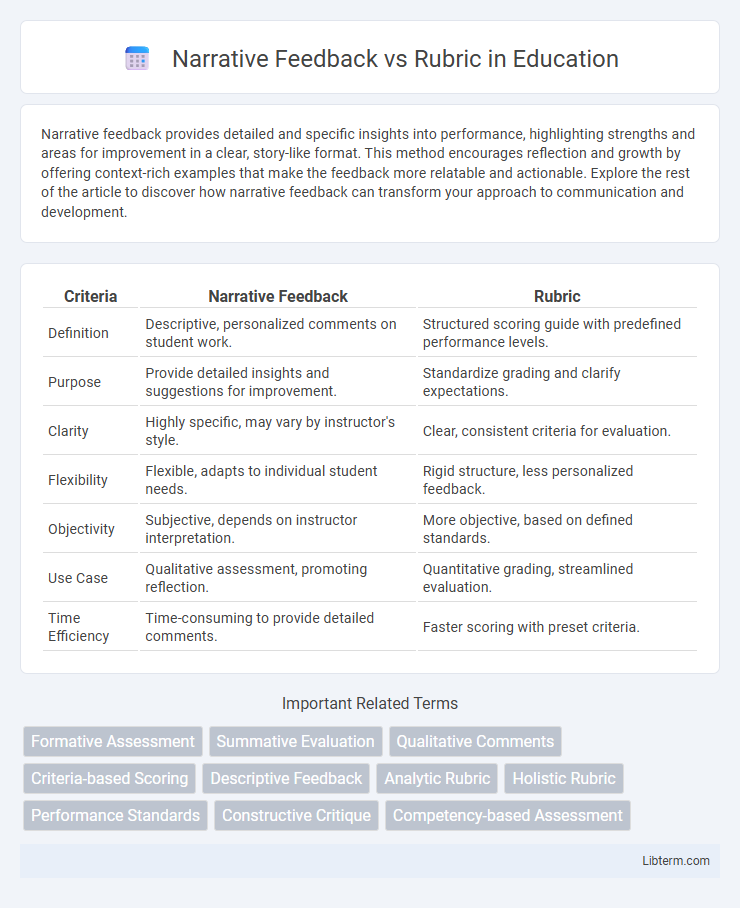Narrative feedback provides detailed and specific insights into performance, highlighting strengths and areas for improvement in a clear, story-like format. This method encourages reflection and growth by offering context-rich examples that make the feedback more relatable and actionable. Explore the rest of the article to discover how narrative feedback can transform your approach to communication and development.
Table of Comparison
| Criteria | Narrative Feedback | Rubric |
|---|---|---|
| Definition | Descriptive, personalized comments on student work. | Structured scoring guide with predefined performance levels. |
| Purpose | Provide detailed insights and suggestions for improvement. | Standardize grading and clarify expectations. |
| Clarity | Highly specific, may vary by instructor's style. | Clear, consistent criteria for evaluation. |
| Flexibility | Flexible, adapts to individual student needs. | Rigid structure, less personalized feedback. |
| Objectivity | Subjective, depends on instructor interpretation. | More objective, based on defined standards. |
| Use Case | Qualitative assessment, promoting reflection. | Quantitative grading, streamlined evaluation. |
| Time Efficiency | Time-consuming to provide detailed comments. | Faster scoring with preset criteria. |
Understanding Narrative Feedback
Narrative feedback provides detailed, personalized insights that help learners understand their strengths and areas for improvement beyond numerical scores. It enhances comprehension by offering specific examples and suggestions tailored to individual performance, fostering deeper learning and skill development. Unlike rubrics, which categorize performance into predefined criteria, narrative feedback promotes critical thinking and reflection by explaining the reasoning behind assessments.
What is a Rubric?
A rubric is a scoring tool that outlines specific criteria and performance levels for evaluating assignments, projects, or exams with consistent and objective standards. It breaks down assessment into clear categories such as content, organization, and mechanics, each with detailed descriptions of what constitutes varying degrees of quality. Rubrics provide transparent expectations for students and streamline grading by offering quantifiable benchmarks rather than subjective judgments.
Key Differences Between Narrative Feedback and Rubrics
Narrative feedback provides personalized, detailed insights into a student's performance, emphasizing strengths and areas for growth, whereas rubrics offer standardized, clear criteria with specific performance levels for objective assessment. Rubrics enhance consistency and comparability across evaluations by breaking down tasks into measurable components, while narrative feedback fosters deeper understanding through qualitative explanation. The key difference lies in rubrics' structured scoring versus narrative feedback's individualized, descriptive nature.
Advantages of Narrative Feedback
Narrative feedback offers personalized, detailed insights that guide learners in understanding their strengths and areas for improvement, fostering deeper comprehension and skill development. Unlike rubrics, narrative feedback provides context-specific examples and constructive suggestions, promoting critical thinking and motivation. This qualitative approach enhances the learning experience by addressing unique student needs beyond standardized criteria.
Benefits of Using Rubrics
Rubrics provide clear, consistent criteria that enhance grading transparency and fairness, enabling both instructors and students to understand expectations and performance standards precisely. They streamline the evaluation process by breaking down complex assignments into specific components, facilitating efficient and objective assessment. Using rubrics also promotes detailed feedback, helping students identify strengths and areas for improvement aligned with defined learning outcomes.
Challenges with Narrative Feedback
Narrative feedback poses challenges such as subjectivity and variability in evaluator interpretation, leading to inconsistent assessments and difficulty in tracking progress over time. Unlike rubrics, which provide clear criteria and standardized scoring, narrative comments often lack specificity, making it harder for learners to identify actionable steps for improvement. The time-intensive nature of crafting detailed, personalized narratives also limits their practicality in large-scale evaluation settings.
Common Limitations of Rubrics
Rubrics often impose rigid criteria that may oversimplify complex student performance, limiting personalized evaluation and nuanced feedback. They can restrict creativity by encouraging conformity to predefined standards rather than fostering innovative thinking. Narrative feedback complements rubrics by providing detailed, individualized insights that address specific strengths and areas for improvement, enhancing the overall assessment process.
Choosing the Right Assessment Method
Choosing the right assessment method depends on the learning objectives and the desired depth of student understanding. Narrative feedback provides personalized, detailed insights that foster critical thinking and growth, making it ideal for complex or creative tasks. In contrast, rubrics offer clear, objective criteria that streamline grading and ensure consistency, especially effective for large classes or standardized assessments.
Combining Narrative Feedback and Rubrics
Combining narrative feedback and rubrics enhances assessment accuracy by providing qualitative insights alongside clearly defined criteria. Narrative feedback offers detailed, personalized comments that help students understand their strengths and areas for improvement, while rubrics ensure consistent and objective grading standards. Integrating both methods supports comprehensive evaluation and fosters deeper learning engagement.
Best Practices for Effective Student Assessment
Narrative feedback offers detailed, personalized insights that guide student improvement, while rubrics provide clear, consistent criteria for objective grading. Combining narrative feedback with rubric use enhances clarity and supports comprehensive evaluation by highlighting strengths and identifying specific areas for growth. Best practices include aligning feedback with learning outcomes, ensuring timely delivery, and fostering student engagement through actionable recommendations.
Narrative Feedback Infographic

 libterm.com
libterm.com